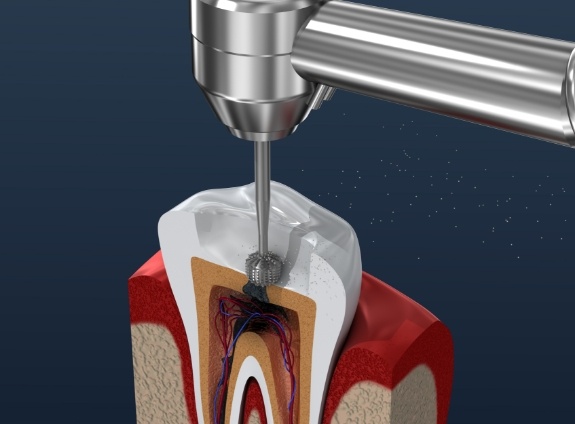Root Canal Treatment – Santa Clarita, CA
Eliminating the Infection For a Pain-Free Smile
Are you nervous about the idea of undergoing root canal treatment? You’re not alone. Many patients worry that the procedure will cause more pain, resulting in regret. The truth is that root canals don’t cause pain but instead eliminate it by removing the infected or damaged pulp. Consisting of various nerves and blood vessels, it is highly sensitive and can create much pain if hindered in any way. By performing a root canal, our in-house endodontist, Dr. Payman Kakoli, can help you not only feel better but maintain a natural tooth structure that will strengthen in the years to come. Learn more about root canal treatment in Santa Clarita by calling us today.
Why Choose A New Smile Dental Canyon Country for Root Canal Treatment?
- Endodontist On Staff
- Advanced Dental Technology
- Enhanced Imaging for Greater Accuracy
Do I Need Root Canal Treatment?

At each of your biannual checkups, our Santa Clarita dental team will conduct a thorough exam, checking for tooth decay, gum disease, and other serious oral health problems in the process. With that said, it’s also important to keep an eye out for abnormal dental symptoms between visits, including:
- Pain when biting down
- Persistent tooth pain
- Dark discoloration on one tooth
- Red, inflamed, or bleeding gums
If any of these arise – or it’s been more than six months since your last checkup – then it’s important that you call us ASAP to schedule an exam.
The Root Canal Process

To start, Dr. Kakoli will administer local anesthesia to ensure your comfort. We will then isolate the tooth using a dental dam. When ready, he will make a small opening in the crown of the tooth before going in to clear away the infection or damage. This means not only removing the affected pulp but also cleaning out nearby canals.
Once this is complete, we will rinse out the tooth to remove any remaining debris before filling it with a solution known as gutta-percha. Once the tooth is sealed, we will put a temporary dental crown into place while a finalized restoration is made. Because it can take several weeks before receiving your permanent crown, you’ll need to follow any instructions provided to you by our team to keep your temporary crown in place.
The Benefits of Getting a Root Canal

If you’re still a bit hesitant to move forward with a root canal, it might be helpful to hear about a few of the many benefits. To start, this emergency dental treatment can eliminate the infection before it destroys your tooth (which requires the tooth to be extracted). Furthermore, the procedure is completely painless thanks to powerful numbing agents and state-of-the-art dental technology. Finally, and perhaps most importantly, a root canal can alleviate the pain you’ve been experiencing in the short and long term!
Understanding the Cost of Root Canals

If you’re like most patients, you have two concerns when it comes to root canal treatment: the pain and the price. The good news is that your time in the treatment chair will be completely painless, and our helpful team will do everything we can to make navigating the financial side of your treatment easy too. Until your appointment (which is when we will be able to provide you with a specific estimate of the price), you can read on to learn more about the factors that impact the cost.
Factors That Can Affect Root Canal Cost

You might be wondering, “Why isn’t there a flat fee for root canal treatment?” The short answer is that there are unique factors we need to consider for each patient. A few examples include the type of tooth that needs to be treated, how complex the case is, and the type of restoration needed to protect the tooth from harm moving forward. Of course, there are other factors as well, including dental insurance. We’ll talk more about that below.
Is it Cheaper to Pull My Tooth?

At first, you might think that you should have your tooth pulled instead, especially since the cost of a tooth extraction looks lower than the cost of a root canal. The reality is that there are other factors that need to be considered, including that having your tooth pulled requires a dental bridge, denture, or dental implant to be added to your treatment plan as well. Plus, there’s nothing quite like your natural teeth, which is why we want to preserve them whenever possible.
Does Dental Insurance Cover Root Canal Treatment?

Oftentimes, yes! For example, if you have the 100-80-50 coverage structure on your dental plan, then upwards of 50% of the cost of root canal treatment may be covered by your provider. Of course, there is lots of red tape to consider – from waiting periods to annual maximums. That’s why it’s crucial that you read through the fine print on your plan first.
Other Options for Making Root Canal Treatment Affordable

If you don’t have dental insurance, you might be wondering what your options are for making the cost of root canal treatment more affordable. Well, there are several options at A New Smile! The first is CareCredit, which allows you to choose a payment plan that works best with your monthly budget. The second is our special offers that help you lower your out-of-pocket expenses. If you’d like additional details on either of these financial solutions, let us know so we can help.
Root Canal FAQs
Are Root Canals Painful?
Before the invention of modern anesthetics, root canals gained a reputation because of the pain they caused. However, dentistry has come a long way since then. Today, a root canal at A New Smile Dental Canyon Country is equivalent to getting a filling in terms of discomfort. Your dentist will make sure that you’re comfortable before the treatment begins. Once your mouth has been numbed, you shouldn’t feel a great deal of pain, but there may be some discomfort and pressure from the instruments. Some patients also experience some soreness in their jaw from holding their mouth open, or sensitivity in the treated tooth once the procedure is over. Rest assured that this discomfort is temporary and should subside within a few days.
Do Root Canals Ever Have to Be Redone?
Root canal treatments have one of the highest success rates in dentistry, but there is a small chance that the procedure may need to be redone in the future. Retreatment is rare, but it can happen for several reasons, including poor oral hygiene after the treatment or saliva contaminating the tooth during the procedure. Root canals on rear teeth are especially complex and hard to reach, so there is also a chance that your dentist missed a root. Whatever the case may be, endodontic retreatment is possible and can be done quickly.
Why Do I Need a Root Canal if My Tooth Doesn’t Hurt?
Intense pain around a tooth is only one sign that you need a root canal, but there are other, more subtle indications that can be missed. This is one reason why scheduling regular dental checkups with us is so important for your dental health. Your dentist can detect the presence of an infection within your tooth that may have destroyed the nerves. This is one reason some patients don’t feel pain in an afflicted tooth. So, while it may not feel urgent, be sure to continue checking in with us every six months to keep your teeth healthy!
What Happens if You Wait Too Long for a Root Canal?
Unfortunately, tooth decay and infections don’t heal on their own, unlike the rest of your body. Once your enamel is broken or eroded, it can’t be restored. The longer you wait to get a root canal, the more damage the infection can cause to adjacent structures like your gums, jawbone, and neighboring teeth. Even if the pain subsides, the problem hasn’t resolved itself—it's getting worse! So, once you feel a toothache, reach out to your dentist as soon as possible. The quicker you receive your treatment, the better off you’ll be.
 Presione Aqui
Presione Aqui